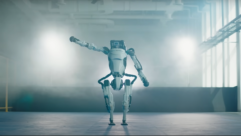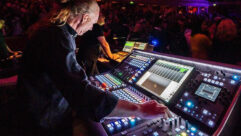
Live Show Control for Entertainment, Part 2
Jul 24, 2012 11:12 AM,
With Bennett Liles
Listen to the Podcasts
Editor’s note: For your convenience, this transcription of the podcast includes timestamps. If you are listening to the podcast and reading its accompanying transcription, you can use the timestamps to jump to any part of the audio podcast by simply dragging the slider on the podcast to the time indicated in the transcription.
Savannah, Ga., is an old town with lots of ghost stories and parties on River Street. The Ghosts and Gravestones tour takes visitors right to the Perkins and Sons Chandlery where Ryan McCurdy has set up an interactive extravaganza with live actors, rain, lighting, and even a scampering animatronic cat. He’s here to tell us how he got it all done, coming right up on the SVC Podcast.
SVC: Ryan McCurdy, it’s great to have you back with me for part two, and we’re talking about the Perkins and Sons Experience in Savannah on Historic Tours of America. Savannah is a really rocking town, so if you’ve got a show put together it has to be interesting because people come down to River Street ready for just about anything. Tell me a little about the show setup. It looks like you’ve got a lot of things going on right from when people walk in the door.
Ryan McCurdy: Well, yeah, I think you hit the nail on the head when you pointed out that people come to Savannah expecting anything so we wanted to give them as much of everything that we could. It’s still the only attraction of its type in Savannah that uses technology with history, but I think the best part of it is that we are telling real stories with a real live actor and so we’re not putting you in a 3D theater with 3D glasses. We’re actually giving you a slice of history just sweeping it a little bit with the effects which is Historic Tours goal. The script is in WinScript, which is Alcorn McBride’s scripting software. It’s got thousands of lines of script mostly from the perspective of the DMX machine. We wanted hard and fast DMX control so we got a DMX machine, we have a lot of lights and space doing a lot of different things so there’s a lot of on’s and off’s and value changes and it’s very fluid, it’s very easy to control but because it’s a haunted quote, unquote venue we—obviously lights flicker, things unexpectedly happen with the lights so as far the DMX machine is running through a ton of dimmers, electronics, AS-40D dimmers which are controlling individual lights and instruments. It’s broken into sequences, each sequence, the actors are taught that the sequences have different lengths, they get to see what the sequences are before they start learning the script so they’re learning the text script and tech script hand in hand which is great. As far as that we also have our recess script, our end of night script, we have a back ground music script, if someone needs to use the space for a private function there’s an hour and a half of background music that can play if you’re using the space in a non-traditional way. There’s the venue demo and the DMX test. The venue demo to show off what the space does in two minutes—the DMX test if you really just need to check all of the channels if something’s not happening and you want to go through the channels one by one. But it’s broken into sequences, WinScript uses sequences like an Excel spreadsheet. You just build rows and rows and rows and name the sequences and then you build Alpha script inside of each of those. So in any given one of those you have a series of DMX commands, you have commands with the V4 as far as talking to the rest of its peripherals and then you have some specialty stuff the reset for instance, putting a hard and fast LCD script up to make sure that the operator knows what’s going on or letting the operator know what is wrong with what peripheral. As far as I know we don’t ever have to use those but they’re definitely in there if the need arises. [Timestamp: 3:33]
Yeah, that must be interesting getting different actors working on the same in general script, each with their own sort of style and pacing and coordinating all of these triggered effects because they’re really running the show.
They are. In fact, I think in part one we talked about the cotton elevator dropping and obviously that’s a very specific special effect. If it were to happen out of control of the actor, it could happen randomly throughout the show, I think it wouldn’t have as much of an emphasis as it does when the actor steps forward looks at the audience, says the man fell from 60ft. and when he landed on the ground and we drop the cotton elevator. So when he’s leaning forward he’s just misdirecting them because he’s going towards a button that he has on the stage to drop the cotton elevator, but the great thing is you have five actors that are working in any given night and sometimes they alternate tour to tour to tour and we’ve given them the control of the special effects—more so than even if they had a board op. We’re giving the actor complete control and the great thing about that is none of them abuse it. You just get really interesting variations on the script. [Timestamp: 4:45]
Tell me about some of the other 4D elements. You’ve got some rain that sprays down on cue?
Well, what’s funny is that’s—we do have rain. We’ve got thunder and lightning. It seems I have every ghost story in Savannah. I lived there myself for eight years before we built Perkins & Sons and have since moved to New York. You’re in for it because all of the ghost stories involve thunder and lighting and a storm, and so it’s no exception on this tour. We decided we could take the chance that it’s raining outside in the tour out there or we could force a storm and make sure everyone gets the same experience. So we’ve got thunder and lightning and then in a complete blackout we have a rain effect and we actually, with no more than you buy at Home Depot, just a ton of cabling and a ton of cutters and splitters and then a DMX sprinkler control, which those things do exist, thank goodness. We are basically irrigating the entire audience. We make sure every seat gets at least a little bit of a splash and it’s in complete black, which of course lets people’s imagination run wild, but I’m proud of saying that it’s the only guaranteed storm in Savannah. [Timestamp: 5:45]
Live Show Control for Entertainment, Part 2
Jul 24, 2012 11:12 AM,
With Bennett Liles
And you’ve got the Alcorn McBride V4 system running the whole show so who maintains that? Say, what happens if you have a power failure? How long does it take to get it all back up and running?
Sure, HTA does have site carpenter and a site maintenance team that took over the reins from me after the design was done, and they have all been trained by me on the V4 and how everything works—a wonderful team. In the event of a power failure there’s actually a bigger problem, which is that if this building goes out all of River Street, pretty much goes out based on where the transformers are. The tour itself would be rerouted for safety concerns, so we actually saved a lot of money not having to get a specialized generator for the space because the tour itself is rerouted in the event of a power outage. Now if there was a power outage and when it comes back up we could start the tour in about 30 seconds. The only thing that would need to happen is if one manual reset. We keep the cotton elevator on a manual reset just for safety sake; it’s winched back into position manually by the actor rather than being computer controlled, which was a choice that we did actively make. So the only thing that you have to do is winch that cotton elevator back into position, let it catch the hydraulic and the magnet, and then basically step back. The system, the V4, resets within about 10 seconds, runs a quick 30-second audio test, and the trolley could be pulling up in the next minute and you would be ready to go. [Timestamp: 7:09]
OK, you have the DMX machine for lighting and you have lightning effects and so forth. How do you use the Megaflash 800W strobe? Is that what you use for the lighting?
It’s a combination of using it for lightning and using it as sort of a freak out effect because each two strobes—we have one on each side of the space; they cover a lot of ground and we looked long and hard. Megaflash turned out to be the best supplier. They have incredible longevity, the lamps do. The throw is huge and the control of frame to frame is tremendous, so yeah, we use those sparingly. Obviously you don’t want to overdo any particular effect, but we use those especially in combination with two industrial strength fans to give another 4D element that even before they get wet they get the sensation that air is starting to move in an uncomfortable fashion and definitely it’s moving faster and harder than the air conditioning. Which is one thing we did have to mix with is it was an unintentional 4D effect that obviously the space had to be air conditioned because the space gets to be 104 or 105 in Savannah in the summer. So I love it when people come in they and say oh it’s so nice and cold and then they sit down and they feel great and then when the fans start they actually start feeling the hairs on their arm moving; people start to freak out, which I love. [Timestamp: 8:32]
It has to be a lot of fun working on something like that. How does the initial testing go on a system like this? At what point do you bring the actors in? After you have all the wiring connected and the effects tested?
Right, the actors came in very early. The first person from the creative end to come in was from the MOD, who also was our scriptwriter and our script supervisor. He was there right from the beginning. He saw us just loading the basics in and he started walking around the room getting the feel for it from that sensibility. He was with us as we started plugging everything in and testing it out—started working on the stories from there. The actors were in probably about a month and a half in and they had a good two to three weeks of just running it with us. We would demonstrate something for them and then let them give their theatrical flair to it, and obviously there were rehearsals that went better than others. This is a very unique type of experience of which I do not know of many that are like this. I have definitely seen 3D films all over the country and I’ve definitely seen where you just have a 4D show which is completely computer controlled but no actor, but the two things together are very rare. So we had rehearsals where we weren’t sure whether this thing was going to work and then I remember one rehearsal where it just clicked; we didn’t see the actors hitting the buttons any more as much as we were looking for them, and the fun of that, just the huge round of applause that we got at the end was very, very fulfilling. It’s definitely fun to build any one of these types of attractions, but man when you add a live actor to it, it gets in people’s faces and the scaring them to death and then you get to rain on them. It’s great. [Timestamp: 10:02]
And you’ve even got an animatronic cat running through the place in the middle of the show?
There’s a animatronic cat at one point that flies across a shelf and knocks some cans over, and we have had people that they see that cat and they are looking around saying, “Where’s that cat? Where’s that cat?” I mean they are, because we create the cat and then its presence is felt. It plays—it runs across a piano, it knocks a picture frame over, it’s presence is there and yet at one point I said, “You guys want ticklers; do you want to have it run through the audience?” and the honest answer was it’s not a haunted house and we can’t overwhelm our audience. We have families come in and they are getting so freaked out by the idea that a cat might run by their feet that we don’t actually have to do it they do it for themselves. [Timestamp: 10:47]
Yeah, it’s like being the man behind the curtain with all of the levers and buttons to make all these surprises happen. So what’s coming up? What do you have coming up next for Historic Tours of America? Have you got any projects in the works?
Well, we’re very proud to announce they’ve opened a brand new attraction up in Boston, which I did early consulting work on and helped design the initial show control aspects for. It’s the Boston Tea Party ships and experience. It’s a combination of real tall ships that have been built by hand in an marina and then floated to the sight of the museum as well as a museum experience with holograms and talking portraits like we have at the oldest show experience which I know is on this podcast previously. Just a combination of a number of wonderful effects and of course live actors as is Historic Tours best claim to fame. In addition a lot of things brewing, maybe in Savannah, maybe in St. Augustine, there’s some great ideas floating around. Unfortunately we’re not to the point where I can announce what any of them are yet, but I think we’re very excited. I am hoping to go down there in about a month and completely redo an audio animatronic figure, so hey—St. Augustine in the summer ain’t no slouch job; it’s a good way to go. [Timestamp: 12:01]
Really, and having lots of fun doing this in places like Savannah and St. Augustine. I can imagine what a great time it is and all of the ideas you get just from working on the show. Thanks for telling us about it. Ryan McCurdy of Historic Tours of America and the Perkins and Sons Experience right there on River Street in Savannah. Good luck on the projects coming up.
Thank you very much. Hopefully we’ll build something good and I’ll be talking to you again in a little bit.










